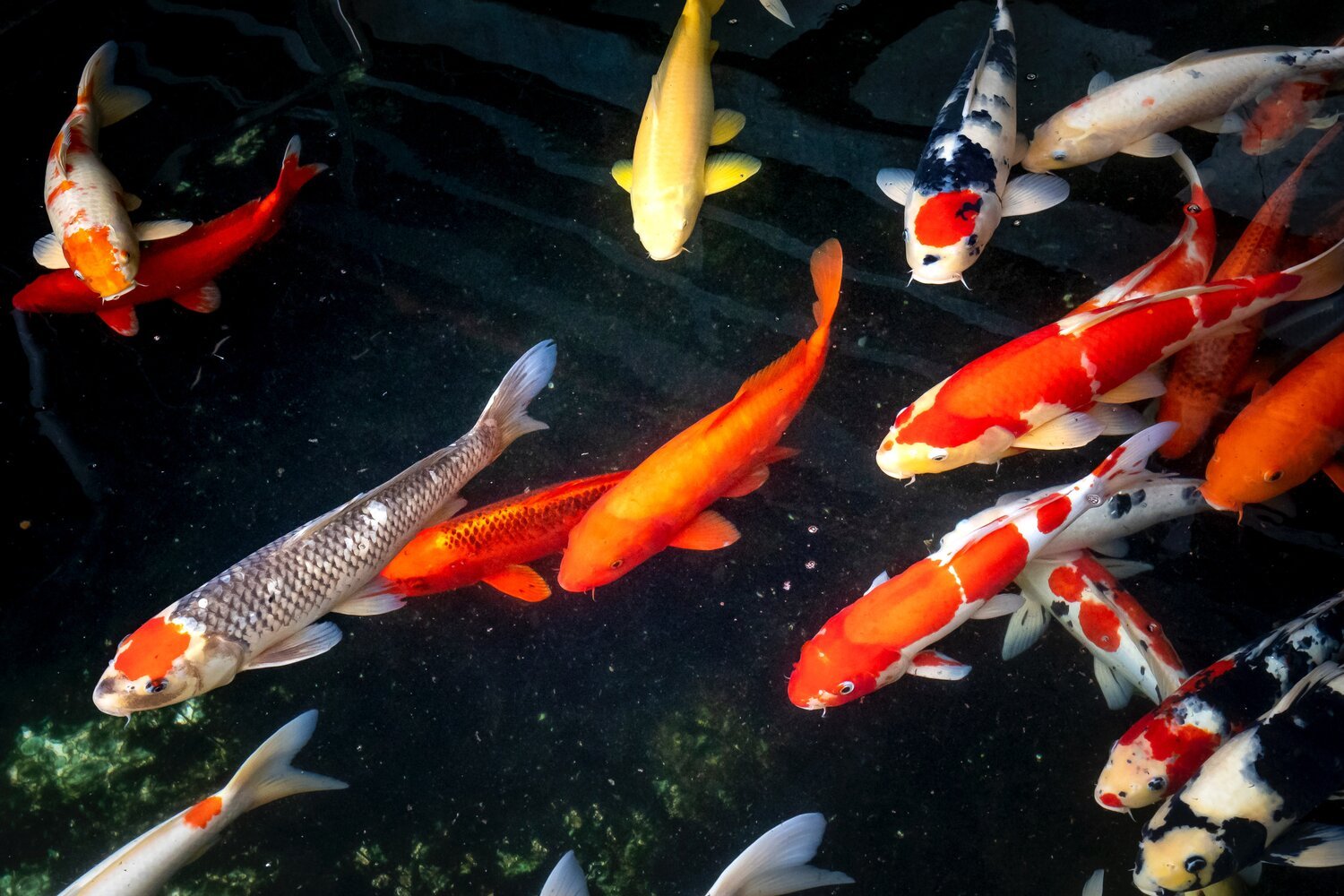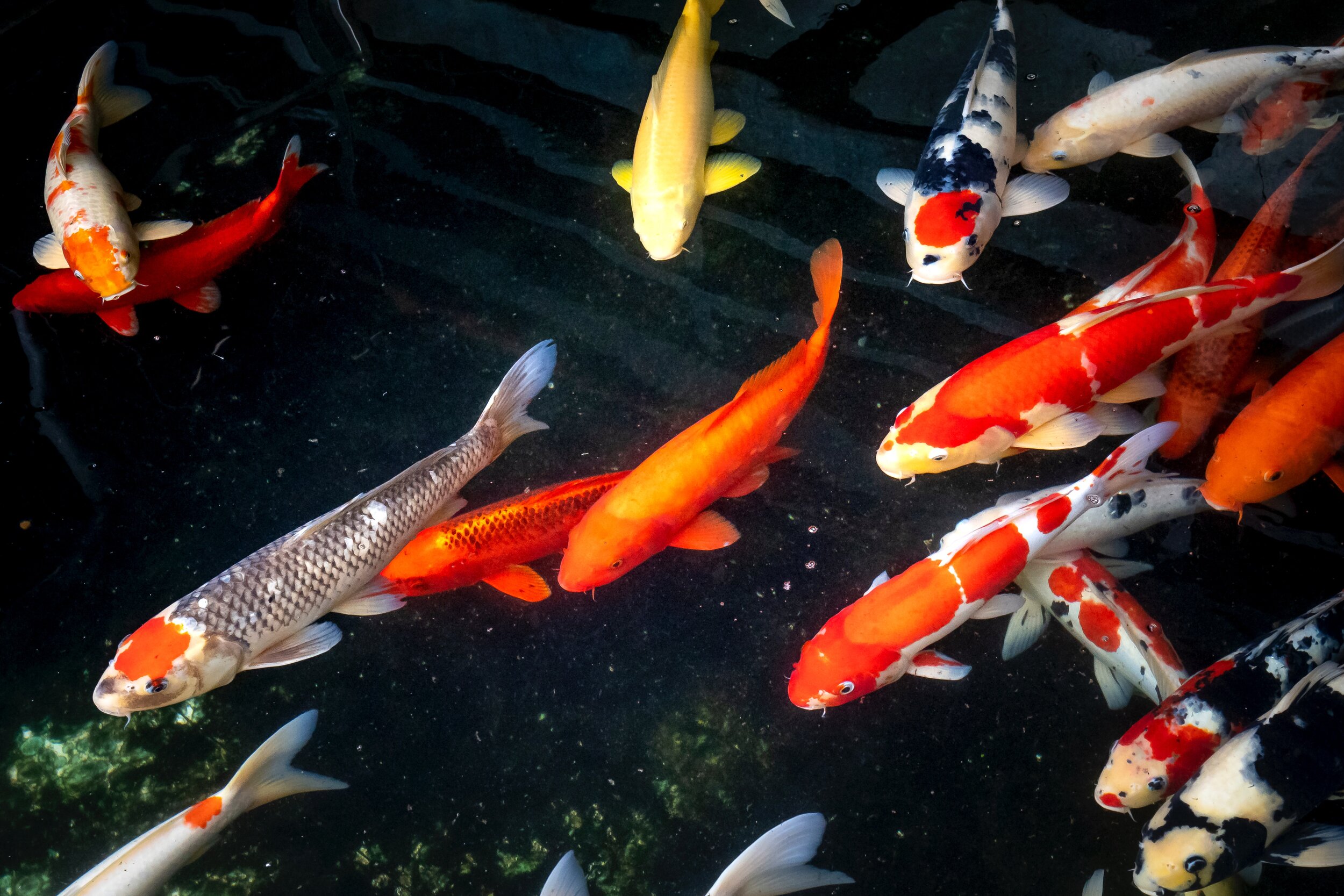Pond Guide Chapter 3: Best Fish For Backyard Pond
Looking for fish for backyard pond? Keep reading to find out.
Image Source: Katherine McAdoo on Unsplash
In the third and final part of our 3-part Pond Guide, Epiphany Ponds & Landscaping. will review the best fish for backyard pond. Before you pick out new pets for your pond, let’s answer some of the following questions:
2. What kind of fish can I put in my pond?
3. How can I keep my fish healthy?
Fish for Backyard Pond
1. Can I add fish to my pond?
Depending on the type of pond you have, the answer is “Yes”.
But not all ponds can support fish or keep them healthy; You can’t just add fish to any pond or else they may die!
Remember, in this 3-part guide on ponds, we have looked at 3 main types of ponds: Ecosystem Ponds, Recreational Ponds and Patio Ponds. While you may be able to support a fish or two in a Patio Pond, and a recreational pond has a section that would welcome fish, the best pond for fish is an Ecosystem Pond.
And here is why: fish are an integral part of an ecosystem. It is where they thrive as they can feed off of the algae in your pond!
With Epiphany Ponds & Landscaping, you will get an ecosystem pond specifically designed to support fish. Your ecosystem pond is designed with the following essential elements: a biological and mechanical filter, a pond pump/recirculating system, aquatic plants, rocks and gravel, and….fish!
The best home for happy and healthy fish is an ecosystem pond.
Image Source: Laura Porter on Pexels.com
2. What kind of fish can I put in my pond?
Generally, there are 3 types of fish that are ideal for ponds in Ontario: koi, goldfish, and other types of fish that are specific to certain climates.
Let’ look at these 3 possible pets.
Types of Fish
Koi
Koi fish may look exotic, but they are hardy pets that can withstand the fluctuations of our Canadian climate. Even if you are not familiar with koi fish, you have probably seen them at some point in your life without realizing it. When I was young, I thought they looked like giant goldfish!
According to the Smithsonian’s National Zoo & Conservation Biology Institute,
Koi fish, whether Japanese or Domestic, come in a variety of colours and, as hinted at, grow to be quite large. In fact, Jumbo Koi fish can grow up to 36 inches or 3 feet in length (It’s a Fish Thing). For that reason, you do not want to home koi fish in a small pond, or if you do, make sure you keep the amount of koi fish to a minimum.
Koi need room to move and grow. Therefore, your pond should be at least 3 feet deep and if you have small koi fish, you need at least 100 gallons of water while larger koi need at least 250 gallons of water. As you increase the number of fish in your pond, the amount of water you need will increase as well. Also, keep in mind that your koi fish will grow in size, so plan accordingly.
I like this guide from Hiner Landscapes:
100-gallons: 1 smaller fish
150-gallons: 1-2 smaller fish
250-gallons: 1-2 koi
300-gallons: 1-2 koi
500-gallons: 2-4 koi
750-gallons: 3-5 koi
1500-gallons: 6-10 koi
If you haven’t read about caring for koi fish, take a look at our other blog post, Essentials of Koi Fish Care for Backyard Ponds to learn more.
Koi in their kaleidoscopic colours adorn your pond and make hearty pets if cared for properly.
Image Source: Quang Nguyen Vinh from Pexels
Goldfish
These fishies are what many think of when they think of pet fish. Like koi, goldfish can also survive in outdoor ponds in Ontario. Popular goldfish for ponds are Sarasas Comets and Shubunkins.
Keep in mind that you need to be careful when homing goldfish with koi. Generally, regular goldfish similar in size to koi are able to survive together; however, smaller goldfish may end up as your koi pet’s next dinner.
Niche Pets also warns: "Koi will also eat fish eggs. So if your goldfish or koi lay eggs within the pond, your koi may potentially see these as a fair meal”!
In terms of how much water you need for goldfish, Caring Pets states that “one goldfish needs approximately 10-20 gallons”.
Keep in mind that, in general, fancy goldfish do not do well in outdoor ponds in Ontario unless you bring them in during cooler temperatures.
Goldfish are also hardy pets for your backyard pond.
Image Source: Kaeyla McGee on Unsplash
Other Pond Fish
If koi and goldfish aren’t your idea of the best fish for backyard pond, you could consider Catfish or Barbels. While not as striking in colour or form, these are 2 types of bottom feeders that will help keep your pond clean!
Just watch out for overcrowding in your pond as these 2 fish species can grow to be quite large.
Catfish (Left) and Barbel (Right) are possible fish for backyard pond, too.
3. How can I keep my fish healthy?
Create Space
Fish will get sick if their home is crowded. “If you have more than 10” of fish for every 100 gallons of water, your pond is likely over-populated. Excessive fish waste can cause an imbalance in pond water” (7 Tips to Keep Pond Water Clean by Aquascape).
Check Water Temperature
Since water temperature impacts oxygen levels, as well as the bacteria levels in your pond, you want to keep an eye on your pond’s temperature. For the fish we have mentioned in this post, water between 15 and 25 degrees Celsius is sufficient; however, the ideal temperature is somewhere between 20 and 23 degrees Celsius (It’s a Fish Thing). Also, if you do a water change, make sure to gradually acclimate your fish to the water as they are sensitive to temperature changes.
Maintain Water Quality
To make a happy home for your fish, make sure to check the following:
pH levels: According to Nextdaykoi.com, between 7.0 and 8.6 is the ideal pH reading.
Nitrites and Nitrates: You don’t want any nitrites in your pond and you want to make sure the nitrate levels are low, too.
Ammonia: Ammonia is not good for your pond or your fish. If you have ammonia problems, consider adding Beneficial Bacteria to combat this or add ammonia removers such as Ammonia Neutralizer by Aquascape.
Feed Carefully
Although your choice of fish food may vary, don’t overfeed your fish. Leftover fish food is left to decay and will upset the balance of your water’s quality.
Also, choose a high-quality fish food, one that is high in protein, low in fat, and complete with added vitamins and probiotics if possible.
Stop excess waste buildup and unhealthy water conditions by preventing overcrowding.
Image Source: Photo by Quang Nguyen Vinh from Pexels
4. What are the best plants for fish ponds?
Plants provide natural filtration for your pond, help maintain your pond water’s quality by absorbing carbon dioxide and ammonia, and provide nourishment, shade, and protection for your fish.
Among the many pond plants that fish and pond-owners like, here are some suggestions:
Water Lettuce
Water Lotus
Creeping Jenny
Waterlilies
Duckweed
Water Hyacinth
Plants help provide fish with shelter and protection from the sun and predators.
Image Sources: Jan Canty (Left), Dave Hoefler (Center) & Saunak Shah (Right)
5. What do I do with my fish in the winter?
In this article, we’ve listed fish that can generally survive the winter in Ontario ponds (“as long as it doesn’t freeze solid and they have adequate water quality and oxygen”) If you are unsure whether your fish can live outside in the winter or not, contact Clearwater for help.
But, have you ever wondered how fish survive the winter in a pond?
Well, it turns out that they become dormant, settle near the bottom of the pond for warmth, and reduce their feeding because of their lowered metabolism. For more details on this process, read this interesting article, How Do Fish Survive Winter in Ponds? by Finns Fishing Tips.
Next, check out the video below provided by Aquascape on how to prepare your pond and fish for the Fall and Winter seasons.
Find out how to prepare your pond and fish for the Fall and Winter.
With so many details to think about in planning, preparing and maintaining a pond (and your pets), you may want help from the experts. Get professional advice and trustworthy service from the friendly staff at Epiphany Ponds & Landscaping.
Having served in Eastern Ontario as Certified Aquascape Contractors for over 10 years, Clearwater will help bring this Pond Guide to life and give you the pond of your dreams.
No matter what stage you’re at with your pond - from pre-planning to fall maintenance, Contact Epiphany Ponds & Landscaping today for all your pond needs.
Testimonials
“Fantastic customer service. They are so friendly and helpful every step of the way.”
“To say it quick and simple Tim and Joey are amazing. This was a big idea for us (20x40 pond, plus intake bay, plus wetland filtration area) and a big investment for us. The idea and research started over a year before the project did and we were nervous because of the lack of information or companies that did a large scale recreational ponds. Tim and Joey gave us the time and information we needed to comfortably move forward. We never felt rushed and they always clearly and thoughtfully answered our questions and explained options or scenarios. They listened to our thoughts and ideas and brought them to life in a way that was beyond our expectations. Their dedication and love for what they do shines through in the work that they do. They are artists and we and everyone who sees what they have done are blown away by the beauty of their creation. Thank you both for your efforts, your patience and your vision. We could not be happier and you should both be very proud of the work you did at our home. 10/10 ⭐️⭐️⭐️⭐️⭐️ stars”













